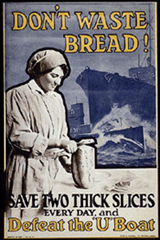

As we have seen, an advertisement can be very simple, and simple advertising, eg for events, has been around for a long as people have been trying to make money out of attracting a wider public. Posters announcing an event were probably the first form of advertising, and these date back to gladiatorial contests in Ancient Rome. The first advertisements, however, which fit our full definition of advertising (ie paid for, occupying space in a media form) appear in newspapers in the seventeenth century. These tended to be straightforward statements of fact, without any fancy typesetting or illustrations, and were often indistinguishable from the news stories around them. As the eighteenth century wore on, the Industrial Revolution gathered pace, and consumer goods became more sophisticated, manufacturers began to recognise that they needed to create a need for their products. Many items were new to consumers, or were new variations. Josiah Wedgewood, who manufactured pottery in England in the second half of the seventeenth century, was particularly good at creating new markets for his wares through advertising. He brought cups and plates into the budget and households of middle class families - a much larger market than the wealthy aristocratic households who had previously been the only purchasers of dinner sets.
The nineteenth century saw the skills of the advertiser come to the forefront, as ads began to mix images and words, and adopt the techniques of language and layout that we are familiar with today. With the proliferation of goods and services in this century, it became recognised that advertising was an important part of business, and should be dealt with by experts in the field. Most of the advertising agencies that dominate the global markets today were founded in the latter part of the nineteenth century.
 During
the early part of the twentieth century, governments began to recognise the
power of advertising to get their message across to their 'consumers' (ie their
citizens). This was particularly apparent during the First World War, when advertising
was used to enlist soldiers and enforce government policies. We look back at
some of these advertisements now and think of them as blatant propaganda,
or the deliberate spreading of ideas in order to further a cause. Many of these
ads use techniques of psychological manipulation which now seem to us crude
and unfair, deliberately setting out to frighten the target audience, or shame
them into following instructions. These posters assume a very specific power
relationship between advertiser and audience, and we notice that the advertiser
assumes that they know best and are giving the audience information for their
own good. A modern audience has a more sophisticated approach to advertising
and is more sensitive to any attitudes which might be considered openly patronising.
How do you think a modern audience might respond to the poster on the right?
During
the early part of the twentieth century, governments began to recognise the
power of advertising to get their message across to their 'consumers' (ie their
citizens). This was particularly apparent during the First World War, when advertising
was used to enlist soldiers and enforce government policies. We look back at
some of these advertisements now and think of them as blatant propaganda,
or the deliberate spreading of ideas in order to further a cause. Many of these
ads use techniques of psychological manipulation which now seem to us crude
and unfair, deliberately setting out to frighten the target audience, or shame
them into following instructions. These posters assume a very specific power
relationship between advertiser and audience, and we notice that the advertiser
assumes that they know best and are giving the audience information for their
own good. A modern audience has a more sophisticated approach to advertising
and is more sensitive to any attitudes which might be considered openly patronising.
How do you think a modern audience might respond to the poster on the right?
Click here for some analysis of a propaganda poster from 1916.
Advertising was a large, well established industry in 1914 and it continued to expand after the First World War. Psychology was growing in stature as a science during this period, and advertisers where quick to latch on to key ideas (the desire to 'belong', subconscious fears) in order to reach their audience. As new ways of reaching a mass audience became technologically available (cinema, radio) advertising was quick to latch on to new media and became an important way for broadcasters to help fund their programming. Radio was an especially successful way to reach audiences in the 1920s - between 1923 and 1930 60% of American families acquired a radio set. The term 'soap opera' as we know it came into being as soap manufacturers sponsored domestic radio dramas in return for frequent plugs for their product. Listen to some 1920s radio advertising here.
After the Second World War there was both a boom in consumer spending AND a new medium: television. Millions of dollars annually were poured into the coffers of advertising agencies as manufacturers sought to inform newly prosperous consumers of the dazzling array of new goods they could purchase (washing machines, vacuum cleaners, food mixers, TV sets...) that they never previously knew they needed. With the combined impact of image AND sound, it soon became clear that brand recognition was much greater with TV than with radio and soon the airwaves were full of programmes like Kraft Television Theater, Colgate Comedy Hour, and Coke Time as advertisers scrambled to access this new wave of consumers. This is sometimes referred to as the single-sponsor era, as the tv programmes were actually produced by the advertising agencies and paid for by a single sponsor. The 1950s were bonanza years for advertising, and it was at this stage that the men (mainly) behind the ads became media stars and shot into the league of the super-highly paid. Men such as David Oglivy and Leo Burnett graced the covers of magazines and were seen to have real power by the rest of the business world. Their theories of advertising were seized on by agencies around the world, and much of their thinking is still part of advertising practice.
As the 1960s began, the networks wanted more control over the content and style of programming, and as TV became more sophisticated and production costs rose, single sponsors began to struggle. NBC executive Sylvester Weaver came up with the idea of selling not whole shows to advertisers, but separate, small blocks of broadcast time. Several different advertisers could buy time within one show, and therefore the content of the show would move out of the control of a single advertiser - rather like a print magazine. This became known as the magazine concept, or participation advertising, as it allowed a whole variety of advertisers to access the audience of a single TV show. Thus the 'commercial break' as we know it was born.
For a more in-depth look at the history of advertising, try the Advanced page.
 You
will need to use the links below to help you find 2 print advertisements, from
two of the following three periods of history:
You
will need to use the links below to help you find 2 print advertisements, from
two of the following three periods of history:
Write a brief explanation of each advertisement and the lines of appeal it uses. Assess how effective that advertisement would be in its own time, and then assess how well it would work today. Explain why today's audience might react differently to the ad.